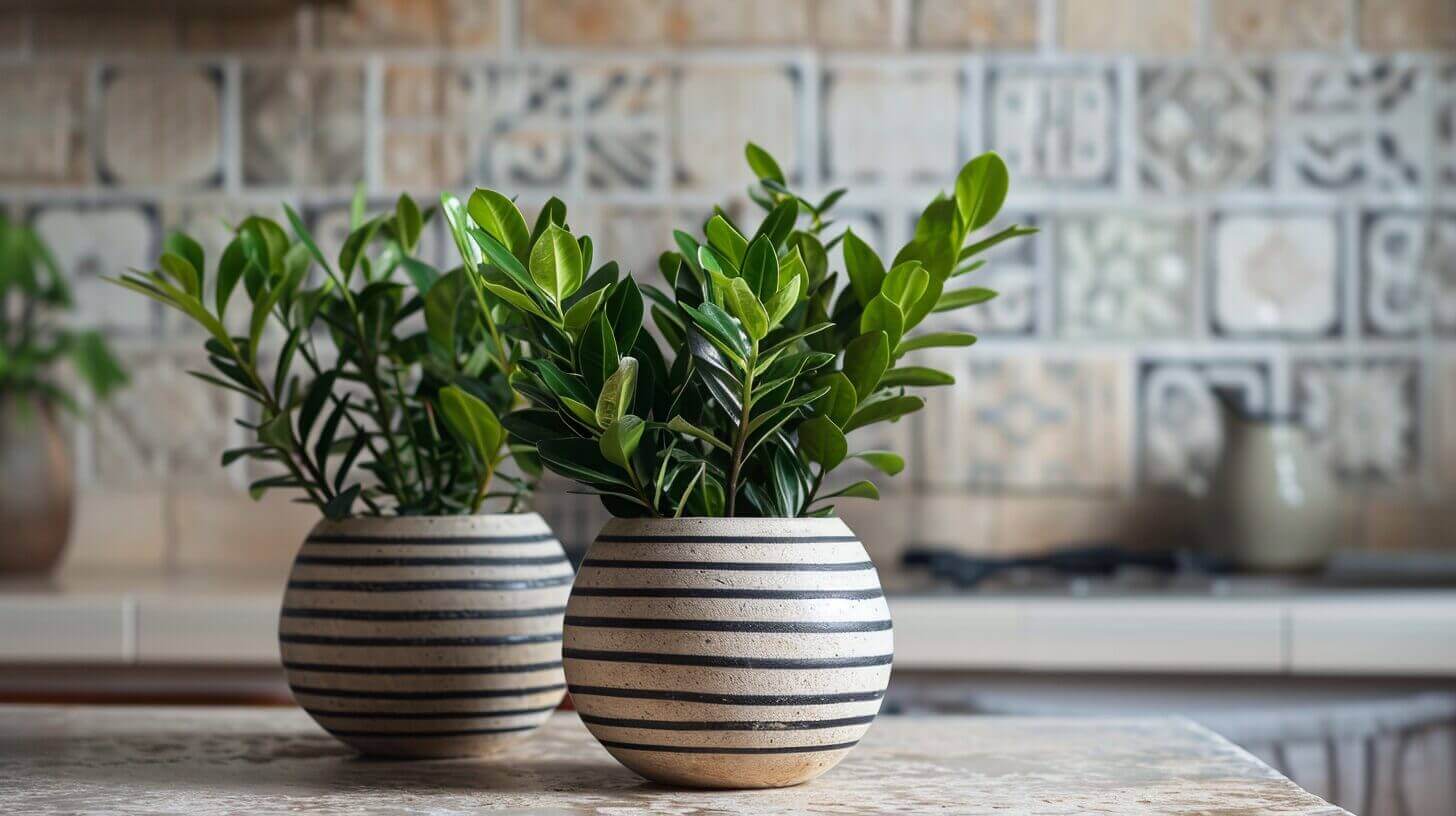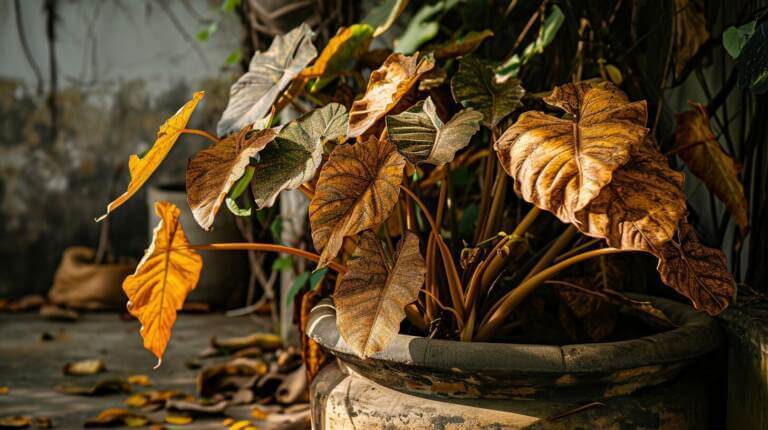Indoors ZZ Plant Care Guide(Zamioculcas Zamiifolia): Complete Guide for Beginners
In a world bustling with fast-paced lifestyles and ever-changing trends, finding solace in nature can be a rare gift. Enter the ZZ plant, a resilient and captivating houseplant that offers a sanctuary of tranquility within the confines of your own home.
This complete care guide for beginners aims to unravel the mysteries of nurturing a ZZ plant with utmost expertise, empowering you to cultivate not only a thriving botanical companion but also a sense of belonging to the natural world.
Key Takeaways
- ZZ plants can thrive in low light conditions and are suitable for indoor spaces with limited natural light.
- The ideal environment for a ZZ plant includes indirect light, proper humidity levels, and a temperature range of 65-75°F (18-24°C).
- ZZ plants prefer to dry out between watering sessions and should be thoroughly soaked until water drains out of the pot.
- ZZ plants can tolerate both natural and artificial lighting, with a recommended distance of 2-3 feet between the plant and the light source.
Understanding Indoor ZZ Plant Care Guide
In this beginner’s introduction to the ZZ plant, we will delve into the various aspects of understanding this resilient plant, including its growth patterns, care requirements, and propagation methods.
The ZZ plant, also known as Zamioculcas zamiifolia, is a popular choice among plant enthusiasts due to its unique characteristics. This plant features glossy, dark green leaves that grow in a feather-like pattern, giving it an elegant and tropical appearance. One of the most remarkable attributes of the ZZ plant is its ability to thrive in low light conditions, making it an excellent choice for indoor spaces with limited natural light.
When it comes to propagation, the ZZ plant can be propagated through division or leaf cuttings. Division involves separating the plant into smaller clumps, each with its own root system, while leaf cuttings can be taken from healthy leaves and placed in a well-draining soil mix to encourage new root growth. Both methods have been proven successful in propagating ZZ plants.
Now that we have explored the characteristics and propagation methods of the ZZ plant, let’s move on to establishing the ideal environment for your ZZ plant.
Ideal Environment for Your ZZ Plant(Zamioculcas Zamiifolia)
To ensure optimal growth and health of your ZZ plant, it is crucial to create an environment that meets its specific requirements. This includes providing the right amount of indirect light and maintaining proper humidity levels. Creating a healthy ZZ plant habitat involves understanding the plant’s natural habitat and replicating it as closely as possible.
One of the key factors in creating the ideal environment for your ZZ plant is ensuring proper temperature. ZZ plants are native to regions with warm climates, so it is important to keep them in a temperature range of 65-75°F (18-24°C). Extreme temperature fluctuations should be avoided, as they can stress the plant and affect its growth.
In addition to temperature, humidity levels also play a significant role in the health of your ZZ plant. These plants prefer moderate to high humidity, so it is beneficial to place them in a room with a humidity level of 40-60%. If the air in your home is dry, you can increase humidity by using a humidifier or placing a tray of water near the plant.
Watering Your ZZ Plant Houseplant: Quick Care Guide
Achieving the perfect balance between hydration and soil moisture is essential for the optimal growth and health of your ZZ plant. Mastering watering techniques and preventing overwatering are crucial aspects of caring for this resilient houseplant.
The ZZ plant, also known as Zamioculcas zamiifolia, is native to drought-prone regions of East Africa. This makes it highly adaptable to low water conditions, making it a popular choice for beginners. However, knowing how to water it properly is still important.
To master watering techniques for your ZZ plant, start by understanding its watering needs. ZZ plants prefer to dry out between watering sessions, so it’s best to water them when the top inch of soil feels dry to the touch. Overwatering can lead to root rot and other issues, so it’s important to avoid keeping the soil constantly moist.
When watering your ZZ plant, make sure to provide a thorough soak. Water until you see it draining out of the bottom of the pot. This ensures that water reaches the entire root system, promoting healthy growth.
To prevent overwatering, ensure that your ZZ plant is potted in well-draining soil and a pot with drainage holes. This allows excess water to escape, preventing waterlogged conditions. Additionally, remember to empty any excess water that collects in the saucer or tray beneath the pot.
Light Requirements of a ZZ Plant(Zamioculcas Zamiifolia Care)
The light requirements of a ZZ plant are essential to understand in order to provide optimal growing conditions for this resilient houseplant. ZZ plants, also known as Zamioculcas zamiifolia, are native to drought-prone regions of Africa and have adapted to thrive in low-light conditions. However, they can also tolerate brighter light as long as it is not direct sunlight.
In their natural habitat, ZZ plants grow under the canopy of taller trees, receiving filtered light. Therefore, they are well-suited for indoor environments with lower light levels. Placing them near a north or east-facing window will provide them with sufficient natural light. However, they can also thrive in rooms with artificial lighting, such as fluorescent or LED lights.
When using artificial lighting, it is important to ensure that the light is placed at a distance of about 2-3 feet away from the plant. This will prevent the ZZ plant from becoming excessively leggy and encourage compact growth. Additionally, it is recommended to provide the plant with 12-14 hours of light per day, replicating the natural day-night cycle.
Troubleshooting Common ZZ Plant Problems
Addressing common ZZ plant problems requires identifying the underlying issues and implementing appropriate solutions to ensure the plant’s health and vitality. One of the most common problems faced by ZZ plant owners is pest infestation. Pests such as spider mites and mealybugs can cause damage to the leaves and overall health of the plant. To control these pests, it is important to regularly inspect the plant for any signs of infestation and take appropriate measures such as using insecticidal soap or neem oil.
Another common issue with ZZ plants is improper pruning. While ZZ plants are known for their low-maintenance nature, occasional pruning is necessary to maintain their shape and remove any dead or damaged leaves. Proper pruning techniques involve using clean and sharp pruning shears to make clean cuts near the base of the stem. It is important to avoid over-pruning, as this can lead to stress and damage to the plant.
Here is a table summarizing common ZZ plant problems, their causes, and solutions:
| Problem | Cause | Solution |
|---|---|---|
| Pest infestation | Spider mites, mealybugs | Use insecticidal soap or neem oil |
| Improper pruning | Over-pruning, incorrect technique | Prune with clean and sharp shears, avoid over-pruning |
| Yellowing leaves | Over-watering, insufficient light | Adjust watering frequency, provide adequate light |
| Root rot | Over-watering, poor drainage | Improve drainage, reduce watering |
| Leaf curling | Low humidity, over-watering | Increase humidity, adjust watering |
Frequently Asked Questions
Can Pruning Help Enhance the Care of My ZZ Plant?
Pruning plays a significant role in maintaining the health and aesthetics of ZZ plants. By following specific zz plant pruning tips, such as using clean and sharp tools, one can remove dead or damaged foliage, encourage new growth, and maintain the desired shape of the plant. Regular pruning can enhance air circulation and prevent the ZZ plant from becoming overly unruly, contributing to its overall well-being.
Can Pruning Help Enhance the Care of My ZZ Plant?
Pruning plays a significant role in maintaining the health and aesthetics of ZZ plants. By following specific zz plant pruning tips, such as using clean and sharp tools, one can remove dead or damaged foliage, encourage new growth, and maintain the desired shape of the plant. Regular pruning can enhance air circulation and prevent the ZZ plant from becoming overly unruly, contributing to its overall well-being.
How Can I Revive My Drooping ZZ Plant According to the Care Guide for Beginners?
If you’re wondering how to revive a drooping zz plant, the care guide for beginners can help. Start by checking the soil moisture and adjusting watering accordingly. Make sure it’s not overwatered or underwatered. Consider increasing humidity levels and providing indirect sunlight. Prune any yellow or dead leaves, and fertilize occasionally. Following these steps may encourage your ZZ plant to recover its vigor.
How Can I Revive My Drooping ZZ Plant According to the Care Guide for Beginners?
If you’re wondering how to revive a drooping zz plant, the care guide for beginners can help. Start by checking the soil moisture and adjusting watering accordingly. Make sure it’s not overwatered or underwatered. Consider increasing humidity levels and providing indirect sunlight. Prune any yellow or dead leaves, and fertilize occasionally. Following these steps may encourage your ZZ plant to recover its vigor.
Can a ZZ Plant Thrive Without Direct Sunlight Near a Window?
The ideal placement for zz plant does not necessarily require direct sunlight near a window. This resilient plant can thrive in low-light conditions, making it suitable for interior spaces with minimal natural light. With its ability to tolerate various light levels and its air-purifying qualities, the ZZ plant can flourish in darker corners of your home or office.
What Are the Light Requirements for a ZZ Plant to Ensure Healthy Growth?
The zz plant sunlight requirements play a crucial role in ensuring its healthy growth. While zz plants can tolerate low light conditions, they thrive best in bright, indirect light. Exposing them to direct sunlight can scorch their leaves, while insufficient light may result in slow growth. Placing the zz plant near a north or east-facing window or using artificial grow lights can help meet its light requirements effectively.
Can I Use Propagation Methods for ZZ Plant Care if I’m a Beginner?
When it comes to ZZ plant care for beginners, using the propagating zz plant cutting method can be an effective approach. This technique involves taking cuttings from the parent plant and rooting them in water or soil. By following this method, beginners can easily create new ZZ plants, expanding their collection and enhancing their gardening skills.
Can Pruning Help Enhance the Care of My ZZ Plant?
Pruning plays a significant role in maintaining the health and aesthetics of ZZ plants. By following specific zz plant pruning tips, such as using clean and sharp tools, one can remove dead or damaged foliage, encourage new growth, and maintain the desired shape of the plant. Regular pruning can enhance air circulation and prevent the ZZ plant from becoming overly unruly, contributing to its overall well-being.
Can I Propagate My ZZ Plant by Leaf Cuttings?
Leaf propagation is a popular method for propagating ZZ plants. It involves taking a leaf cutting from a healthy plant and allowing it to develop roots in water or a well-draining soil mix.
This technique can be an effective way to grow new ZZ plants, but it requires careful attention to best practices. By following the correct procedures, such as using healthy leaves and providing the right conditions for rooting, successful leaf propagation can be achieved.
How Often Should I Repot My ZZ Plant?
When it comes to caring for a ZZ plant, one important aspect to consider is the frequency of repotting. Knowing when to repot your ZZ plant and how to do it without causing stress is essential for maintaining its health and vitality.
Repotting should be done when the plant has outgrown its current container or when the soil becomes compacted. The best time to repot a ZZ plant is during the spring or early summer when the plant is actively growing.
Can ZZ Plants Tolerate Air Conditioning or Heating?
ZZ plants are known for their ability to tolerate a wide range of temperatures, including both low and high extremes. They are adaptable to air conditioning and heating environments, making them suitable for indoor spaces with controlled climates.
However, it is important to note that extreme temperature fluctuations should be avoided, as it can negatively impact the health of the plant. Providing consistent temperatures within the recommended range will help ensure the well-being of ZZ plants.
Are ZZ Plants Toxic to Pets?
ZZ plants are a popular choice among plant enthusiasts due to their striking appearance and low maintenance requirements. However, it is important to consider the safety of our furry friends when introducing new plants into our homes. ZZ plants are known to be toxic to pets if ingested. Therefore, it is crucial to keep them out of reach of curious pets.
In addition to this important consideration, there are various ZZ plant care tips that can help keep these plants healthy and thriving.
What Is the Ideal Humidity Level for a ZZ Plant?
The ideal humidity level for a ZZ plant is between 40% and 60%. Maintaining proper humidity is crucial for the plant’s health and growth.
To increase humidity for ZZ plants, you can use a humidifier, place the plant on a tray filled with water and pebbles, or group it with other plants to create a microclimate.
It is important to avoid excessive humidity, as this can lead to fungal diseases. Regularly monitor the humidity levels to ensure optimal conditions for your ZZ plant’s well-being.
How do I propagate a ZZ plant?
ZZ plant propagation can be done by cutting a leaf or rhizome and planting it in potting mix. Keep the plant in bright indirect light and water it when the soil is completely dry.
How do I care for a ZZ plant?
Care for ZZ plants is easy. They thrive in low light conditions, need less water, and prefer well-draining potting soil. Water the plant only when the soil dries out completely.
What type of fertilizer does a ZZ plant need?
ZZ plants aren’t heavy feeders, so a balanced houseplant fertilizer used according to package instructions during the growing season will suffice.
Can ZZ plants grow indoors?
Yes, ZZ plants make excellent indoor plants. They can tolerate low light conditions and are easy to care for, making them popular among plant parents.
Why are my ZZ plant leaves turning yellow?
Yellow leaves on a ZZ plant may be a sign of overwatering. Let the soil dry out completely before watering again.
Can ZZ plants tolerate direct sunlight?
No, ZZ plants prefer bright indirect light. Direct sunlight can scorch the leaves and cause them to turn yellow.
How often should I repot my ZZ plant?
ZZ plants grow slowly and like to be root bound, so they don’t need to be repotted often. However, if you notice the plant is becoming too large for its pot or the soil is depleted, it’s time to repot.
What type of soil is best for a ZZ plant?
A well-draining potting mix is ideal for ZZ plants. They don’t like to sit in water, so make sure the potting soil you choose doesn’t retain too much moisture.
How do I know if my ZZ plant needs water?
Check the soil before watering your ZZ plant. If the top inch of soil is dry, it’s time to water the plant.
Are ZZ plants easy to care for?
Yes, ZZ plants are known as “eternity plants” or “zuzu plants” because they are so easy to care for. They can tolerate a range of light conditions and don’t require frequent watering or feeding.







